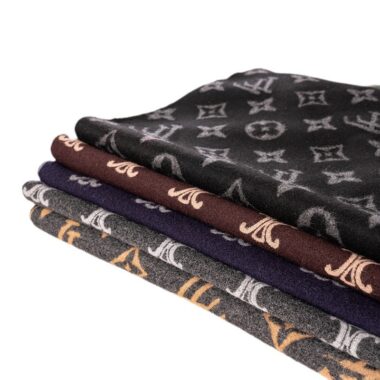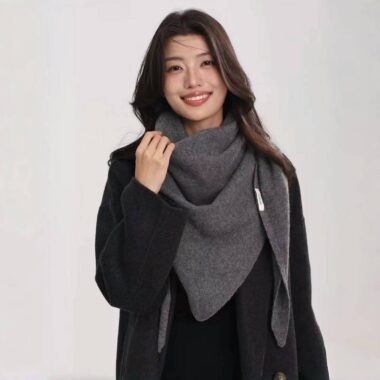Eco-friendly scarves are a great way to stay stylish while making conscious, environmentally-friendly choices. Sustainable fabrics and styles can help reduce the environmental impact of fashion. Here’s a breakdown of the most popular eco-friendly fabrics and scarf styles:
Sustainable Fabrics for Scarves:
- Organic Cotton:
- Why it’s eco-friendly: Grown without synthetic pesticides or fertilizers, organic cotton is better for the soil and surrounding ecosystems.
- Benefits: Soft, breathable, and lightweight—perfect for warmer months.
- Downside: It’s not as warm as other fabrics like wool, but it’s a great option for spring and summer.
- Bamboo:
- Why it’s eco-friendly: Bamboo is fast-growing and requires very little water, and it’s biodegradable. The production of bamboo fabric is generally more sustainable than conventional cotton.
- Benefits: Bamboo fabric is soft, breathable, and moisture-wicking. It’s also naturally anti-bacterial and hypoallergenic.
- Downside: Some bamboo fabrics are processed with chemicals, so it’s important to look for certifications like Oeko-Tex or GOTS.
- Linen (Flax):
- Why it’s eco-friendly: Linen is made from the flax plant, which requires little water and no pesticides. It’s also biodegradable.
- Benefits: Lightweight, breathable, and naturally moisture-wicking, making it perfect for hot weather.
- Downside: It can be a bit stiff compared to other fabrics, but it softens with use.
- Recycled Fabrics (Recycled Polyester, Recycled Wool):
- Why it’s eco-friendly: Using waste materials to create new fabrics helps reduce the demand for virgin resources and lowers waste.
- Benefits: Recycled polyester or wool can be just as high-quality as new materials, often with a smaller environmental footprint.
- Downside: Polyester is not as biodegradable as natural fibers, though recycled versions are less harmful.
- Hemp:
- Why it’s eco-friendly: Hemp is one of the most sustainable crops—it grows quickly, needs little water, and requires minimal pesticides.
- Benefits: Hemp fabric is durable, breathable, and gets softer with time.
- Downside: It can be rougher in texture compared to cotton or silk.
- Tencel (Lyocell):
- Why it’s eco-friendly: Made from sustainably sourced wood pulp, Tencel is produced in a closed-loop process that recycles water and solvents, minimizing waste.
- Benefits: Soft, breathable, and moisture-wicking with a silky feel.
- Downside: Can be a bit more expensive due to its sustainable production process.
Eco-Friendly Scarf Styles:
- Handwoven or Handmade Scarves:
- Why it’s eco-friendly: Supporting artisans who handcraft scarves often means supporting ethical labor practices and small-scale, sustainable production.
- Benefits: Unique, one-of-a-kind designs and often made with natural, sustainable fibers.
- Downside: They can be pricier and less widely available.
- Upcycled or Vintage Scarves:
- Why it’s eco-friendly: Upcycling involves taking old garments or textiles and repurposing them into new items, reducing waste.
- Benefits: Unique, sustainable, and often affordable.
- Downside: Finding the perfect piece might take some time.
- Fair Trade Scarves:
- Why it’s eco-friendly: Fair trade scarves are produced under ethical labor practices, ensuring that artisans receive fair wages and work in safe conditions.
- Benefits: Ethical and sustainable production, often using natural fibers.
- Downside: Fair trade scarves can be pricier due to the labor standards.
- Minimalist and Timeless Designs:
- Why it’s eco-friendly: Choosing scarves with timeless, versatile designs means you’ll wear them for years, reducing the need for constant replacement.
- Benefits: Versatile and long-lasting, often in neutral colors or simple patterns.
- Downside: If you’re into bold, seasonal trends, these might not be as exciting.
Tips for Choosing Eco-Friendly Scarves:
- Look for certifications: Certifications like Global Organic Textile Standard (GOTS), OEKO-TEX Standard 100, or Fair Trade can help ensure a more sustainable and ethical product.
- Buy less but better: Opt for high-quality scarves that will last longer and withstand the test of time.
- Consider the lifecycle: Consider how easy it is to recycle or compost the scarf at the end of its life.
Are you thinking of incorporating eco-friendly fabrics into your scarf collection, or are you looking for a particular type of sustainable scarf?








